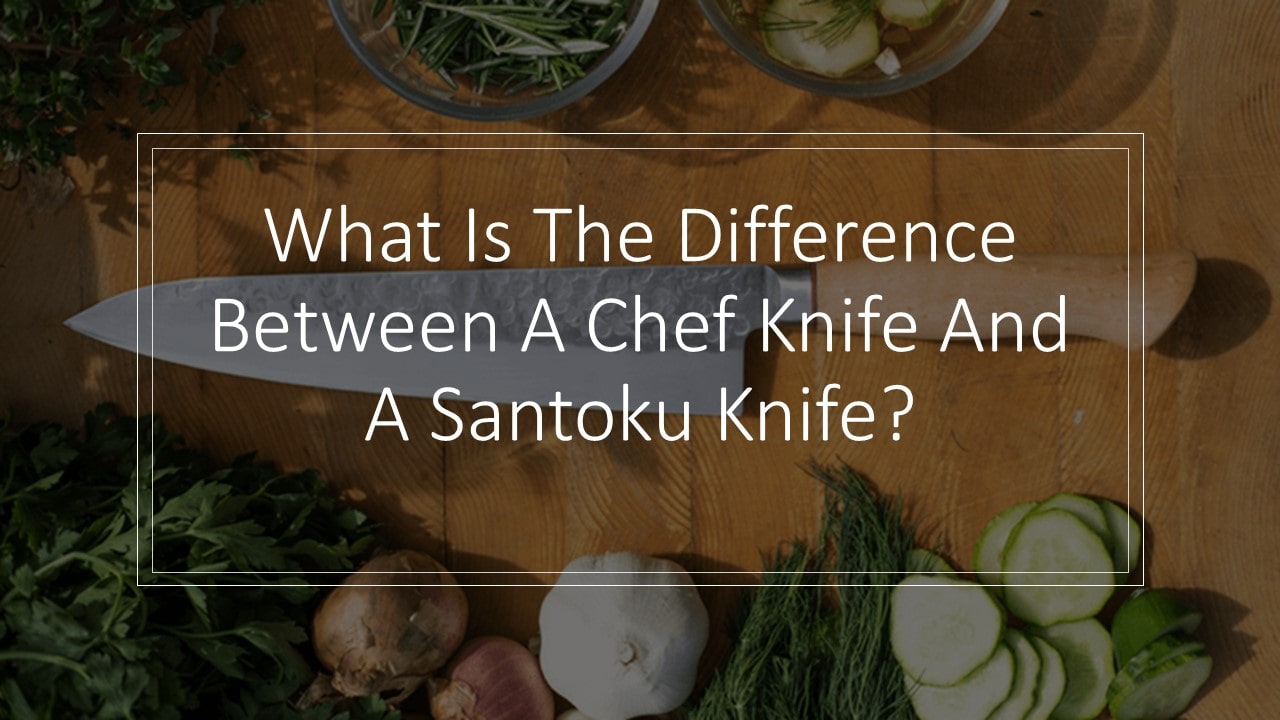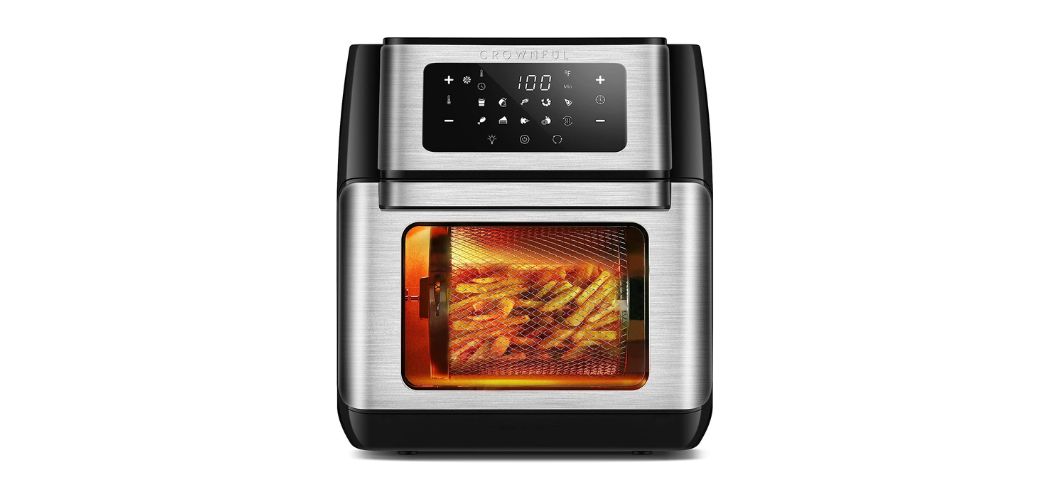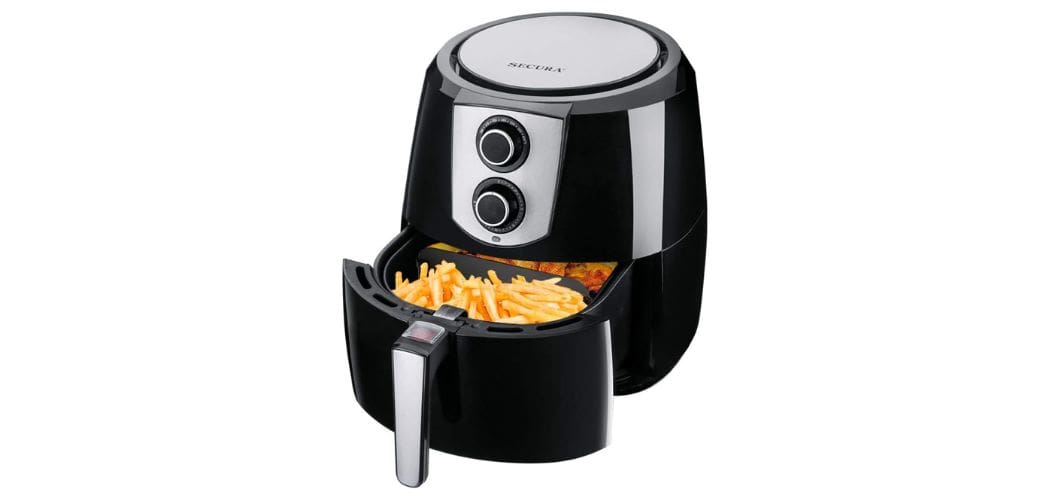There are two varieties of culinary knives that function as versatile kitchen tools in precision cutlery: the standard Western-style chef’s knife and the Asian Santoku knife.
Although both chef knives serve the same goal, they are pretty different in terms of form, design, cutting styles, and procedures.
So which knife should you buy? Do these knives require specific cutting techniques? Read on to know all about the two knives and choose the one which suits your cooking perfectly.
Table of Contents
What Is A Santoku Knife?
A Santoku knife is a Japanese all-purpose kitchen knife with an ultra-light, thick-bladed edge. Unlike the longer-bladed, pointed chef’s knife, these blades have a flat margin and a curved nose.
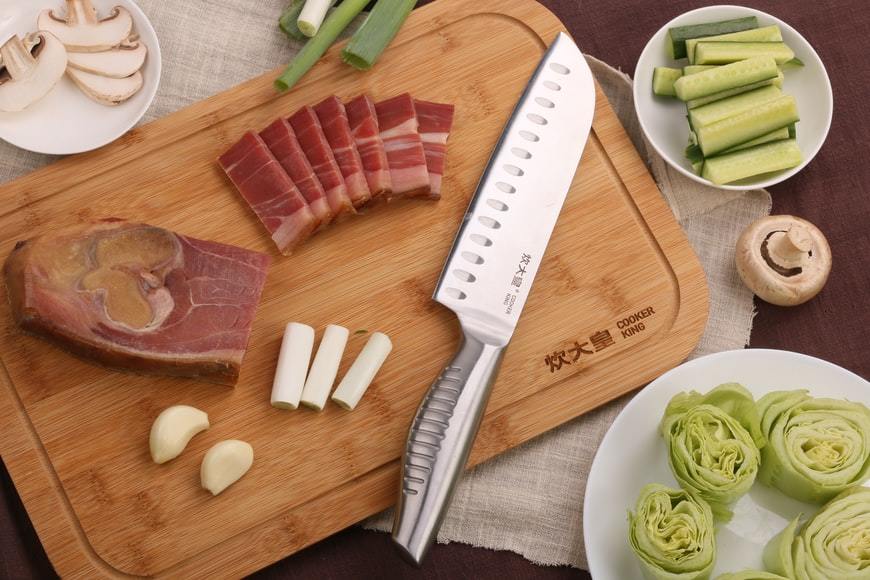
Cooks employ an up-and-down slicing movement with a Santoku knife instead of the slight wobble they may use with a chef’s knife.
A Santoku’s blade and edge are likewise thinner than a chef’s knife.
It makes them suitable for finer tasks like cutting flawless carrot cubes or gorgeous transparent cucumber rounds.
Lighter forged steel is often used in Japanese blades, which hardens the edge, allowing the knives to keep their sharpness for longer.
Still, it makes the blades more difficult to repair at home. You may need to take a worn Santoku knife to a professional to get it back to its original sharpness.
What Is A Chef’s Knife?
Chef’s knives originated in France and Germany, are longer, bigger, and thicker than Santokus. They feature a pointed tip and a gently rounded blade.
The sharp tip may aid in commencing tough cuts, such as cutting through hard butternut squash or slicing through cartilage during butchering, while the curvature lends itself to a slight wobble.
Most chef knives have reinforced or tiny gaps between the edge and the grip where your pointer finger may rest. Cutting using a bolster might be more pleasant and safer. Chef’s knives exist in various sizes, ranging from six inches to over twelve.
Those with bigger hands may prefer longer knives, but most chefs are happy with an eight to ten-inch blade.
Quick Comparison Guide: Chef Vs. Santoku Knife
| Aspects | Santoku Knife | Chef Knife |
| Design | It features a flat or smooth edge. | It has a curved border that bends progressively from heel to tip. |
| Size | Its arms are 4-5 inches long. | It has an arm length of 6-8 inches. |
| Sharpness | It is honed to a 10-degree angle on average | Its blades are sharpened at a 10 to 20 degrees angle |
| Edge grind | Features a single-bevel | Features a double-bevel |
| Price | Less expensive | More expensive |
Chef’s Knife Vs. Santoku Knife: What’s The Difference?
Both these knives do their job well; however, there are several key differences between the two. Here are some major points that tell these two knives apart:
Design Of The Blade:
The form of the blades is the first visible difference between the two knives. A typical Santoku features a flat or smooth edge with a well-defined downward-curved spine.
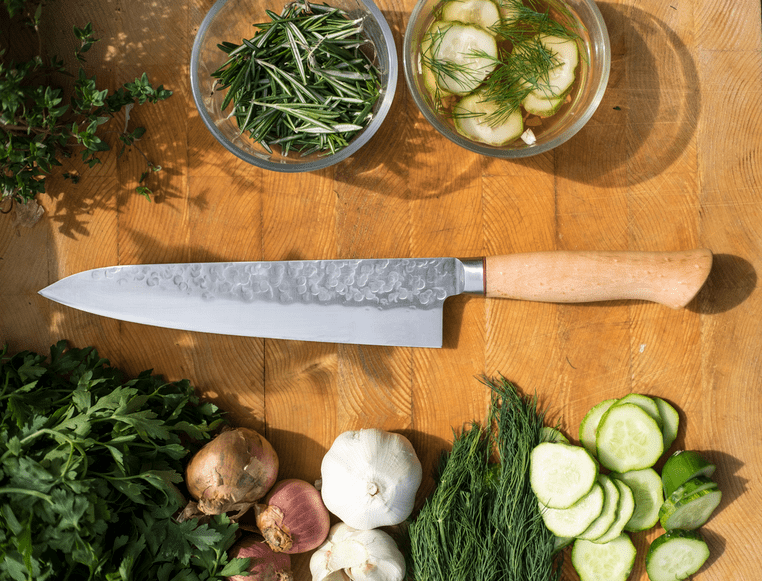
The contemporary chef’s knife, on the other hand, has a curved border that bends progressively from heel to tip, with the back following suit, ending in a relatively straight, pointed tip.
The chef’s knife’s bent blade allows for a rocking movement (rock chop) – ideal for swiftly slicing a carrot or spring onions. You can also use the knife in a slicing motion.
The Santoku is ideal for chopping or cutting in an up and down motion.
That’s not to say you can’t do slicing with a Santoku; it’s simply more difficult owing to the straight edge, which might put unnecessary strain on your hands.
Size:
Chef’s knives offer a wider choice of blade lengths to pick from when it comes to size. Santoku knives are available in various blade lengths, ranging from three inches for a paring knife to nine inches for a chef’s knife.
7 inches is the most common blade height for a Santoku knife. Since most Santoku knives’ arms are 4-5 inches long, the typical Santoku knife’s overall length is 11.5 inches.
Chef’s knives often have blade lengths ranging from 4-5 inches to 14 inches or even over. Large chunks of meat, melons, and pumpkins are simpler to handle with longer blades.
When you include the height of the handle, some chef’s knives might exceed 20 inches in length. Although you may get a chef’s knife in various lengths, the most popular blade lengths are 6 and 8 inches.
Sharpness
Chef’s knives are honed at a lower edge angle than Santoku knives. The narrower the blade angle for the inexperienced, the snappier the knife. If you are new to the world of knives and want comfortable and beginner-friendly knives then make sure to read our full guide.
Santoku knives are honed to a 10-degree angle on average, whereas chef’s knives are sharpened to a spectrum of 10 to 20 degrees, with an estimated value of 15. Santoku knives, in other terms, are often firmer than chef’s knives.
Edge Grind
The kind of edge, or edge grind, is another distinction between Santoku and chef’s knives. Double-bevel and single-bevel are the two most prevalent forms of edges. In the form of a “V,” a double-bevel border is on both sides.
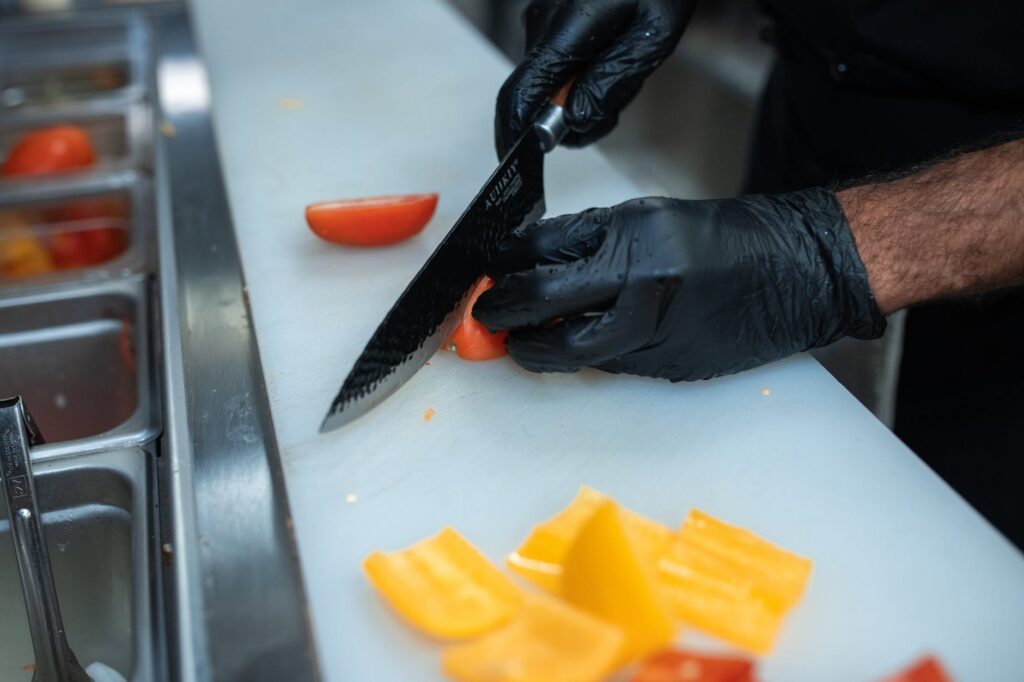
This edge is ideal for daily usage in the home since it can withstand thick, heavy foods and is simple to maintain.
Lefties and righties both may use double-bevel knives since they are pointed on both sides.
You may find a double-bevel edge on almost all chef’s knives and most Santokus.
Although few chef’s knives do, many Santoku knives feature a single-bevel edge. Only one side of a single-bevel border is ground, leaving the other side flat.
Knife manufacturers find it simpler to achieve an ultra-thin edge while working on only one side; therefore, single-bevel blades are very sharp.
The tiny edge is precise enough to cut food into paper-thin slices, common in Japanese cuisine. When slicing sashimi or removing certain fruits and veggies, this extra sharpness comes in handy.
Price
Chef knives are often more costly than Santoku knives; however, this depends on the brand and size of the blade you choose. In general, embossed knives will be less expensive than forged knives.
Knives made with high-quality materials, complex production processes, and distinctive designs such as multilayer steel are often more expensive.
However, if you are someone on a tight budget and looking for knives under $300 then make sure to read our full review. This would help you save a lot of money and time.
What’s The Verdict?
Now that you know the distinctions between Santoku and chef’s knives, the issue is: which one should you use. Is it necessary to have both? Or is it possible to work with only one sort of knife?
The fact is that you can get away with either one. If your primary use is slicing or other fine tasks, you can opt for a Santoku knife that is precise enough for the task. If not, you can go for a chef knife that helps you with tough cuts.
However, as mentioned above, each knife type excels at different cutting jobs. Having both of them makes work a little more straightforward in the kitchen.
FAQs:
Is It Possible To Mince Garlic Or Sliced Veggies With A Santoku?
You may substitute chef’s knives for Santoku knives, but not the other way around.
Chef’s knives are better at cutting vegetables, chopping up garlic, and slashing meat than Santoku knives because the edge is broader and thicker, making it better suited for these jobs.
So while you may be able to slice vegetables or mince garlic with a Santoku knife, a chef’s knife can do it better.
Food containing tiny bones, such as celery or cauliflower, cannot be sliced as readily with a Santoku knife as it can with a chef’s knife.
Some experts prefer the heavier weight of a chef’s knife, while others favor the lesser thickness.
Which Knife Is Suitable For Regular Home Use?
A chef’s knife is a perfect choice if you require an all-purpose blade that can chop, slice, and mince vegetables and other things.
However, a Santoku may be the most acceptable option for your kitchen if you need to cut or crush more delicate foods like garlic and onions.
Can You Use A Santoku Knife For Cutting Meat?
While a Santoku knife is particularly beneficial for speedier, delicate, and precise cutting, it reaches its limitations with heavier meats and tougher veggies, as seen in the comparison above.
Although it may theoretically cut through these items, it might not be as effective as a bigger, more robust chef knife or a butcher knife.
Conclusion
The knife you pick must be the one that best fits your grip and cooking technique. While both knives can help you cut, you need to choose the right one to achieve precision.
A Santoku is more suited for delicate and speedy cuts, but a chef knife is ideal for tough tasks like slicing big vegetables. Moreover, keep the points given above in mind to help you select the ideal knife for your kitchen!

